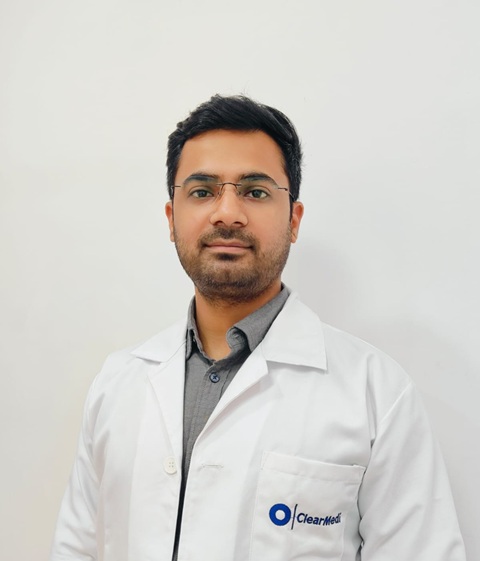Myringoplasty - Meaning, Surgery Procedure and Results

Treatment Duration
1 Hours
------ To ------3 Hours
Treatment Cost
₹ 35,000
------ To ------₹ 75,000

Table of Contents
- What is Myringoplasty?
- Conditions treated with Myringoplasty
- Who needs Myringoplasty?
- How is Myringoplasty performed?
- What to expect before and on the day of Myringoplasty?
- What to expect after Myringoplasty?
- Benefits of Myringoplasty
- Risks and complications of Myringoplasty
- Risks of delayed Myringoplasty
- Cost of Myringoplasty
Myringoplasty is a surgical procedure performed to repair the perforation in the tympanic membrane (eardrum). In this process, the perforation is fixed by placing a graft to patch up the eardrum.
Myringoplasty is usually performed on an outpatient basis. The procedure usually takes 1 to 3 hours to complete. The recovery after the surgery is generally quick and effortless.
| Surgery Name | Myringoplasty |
| Disease Treated | Tinnitus, Vertigo, Hearing loss |
| Benefits of the Surgery | Restores hearing loss, Prevents re-infection, Fewer chances of ear infection, Hearing power is enhanced |
| Treated by | Otolaryngologist (ENT specialist) |
You can check Myringoplasty Cost here.
What is Myringoplasty?
Myringoplasty is a surgical procedure performed to repair the perforation in the tympanic membrane (eardrum). The perforation usually occurs on the more significant part of the eardrum, known as pars tensa. In this process, the perforation is fixed by placing a graft to patch up the eardrum.
Anatomy and Physiology of the Tympanic Membrane (Eardrum)
- The tympanic membrane, or the eardrum, separates the outer ear from the middle ear.
- The membrane lies across the external canal and looks like a flattened cone with its tip pointing inwards.
- It comprises a thin connective tissue membrane covered by the skin on the outside and mucosa on the internal surface.
- This membrane has an abundant supply of blood vessels and also contains sensory nerve fibres that make it extra sensitive to pain.
- This membrane receives sound vibrations from the outside air and transmits them to the auditory ossicles, the tiny bones in the middle ear.
- The bones present in the middle ear transmit vibrations to the inner ear.
Expert Doctors (10)
NABH Accredited Hospitals (10)


Conditions treated with Myringoplasty
Generally, myringoplasty is performed to repair a hole in the eardrum. Myringoplasty also helps treat other conditions such as:
- Tinnitus (ringing in the ear)
- Hearing loss
- Vertigo (spinning sensation)
Who needs Myringoplasty?
Myringoplasty is recommended for those patients who:
- Are suffering from persistent perforation of the eardrum, resulting in enlargement of the hole to the extent that it has reduced the hearing capability,
- Are diagnosed with chronic otitis media (infection in the middle ear) that is causing fluid discharge in the ear and causing gradual eardrum perforation,
- Have dry tympanic membrane perforation for at least six weeks, and
- Have a healthy middle ear mucosa (a membrane that lines the middle ear cavity).
In rare cases, a patient suffering from tinnitus, a continuous ringing sensation in the ear without the presence of an external sound in the environment, must undergo myringoplasty.
Myringoplasty should be avoided if the patient is:
- Experiencing a continued discharge from the middle ear
- Suffering from nasal allergy
- Suffering from Otitis Externa or deafness
- Below sixteen or more than sixty years of age
- Suffering from a deformity of the external auditory canal
- Suffering from upper respiratory tract problems such as sinusitis, chronic tonsillitis, DNS (deviated nasal septum), or pharyngitis
- Suffering from diabetes, cancer, or any other debilitating disease
How is Myringoplasty performed?
Myringoplasty is generally performed to repair minor tears in the tympanic membrane (eardrum). The procedure usually takes 1 to 3 hours to complete, depending on the patient's age, medical condition of the patient and the complexity of the case. The procedure is usually performed under general anaesthesia (medication used to reduce the sensation in the body) by a specialized team of anaesthetist, otolaryngologist (ENT specialist) and other medical staff. The following steps are involved in the procedure:
- The surgeon will administer general anaesthesia to the patient.
- Before starting the procedure, graft material is harvested to cover the hole. Most commonly, temporalis fascia (a strong fibrous tissue covering the temporalis muscle) is used to harvest the graft as it is located near the incision site.
- Myringoplasty can be performed using two types of procedures: the Underlay and the Overlay technique.
- The Underlay Technique: The underlay technique is easier to perform and ideal for repairing small and easily visualised perforations. The steps include:
- The surgeon makes an incision along the perforation to remove a strip of the epithelial layer.
- He or she then places the graft on the inner surface of the tympanic membrane.
- After the graft is placed in the right position, the ear is filled with antibiotic-soaked gel foam to pack the inner ear for stability.
- The surgeon ensures that the graft completely covers the perforation and some of its parts extend over to the walls of the posterior canal.
- The Overlay Technique: The overlay technique is relatively difficult to perform and typically reserved for total perforations, anterior perforations, or a failed underlay surgery.
- The surgeon makes an incision to raise the medial meatal skin of the ear canal.
- The graft is placed at the outer surface of the eardrum. It is made stable by tucking it under the malleus handle (outermost and the largest of the three bones of the middle ear).
- A gel foam soaked in antibiotics is used to pack the inner ear.
- The incision is closed once the graft is placed in the proper position.
- Then the patient is will be moved to the hospital ward so that he/she can recover.
What to expect before and on the day of Myringoplasty?
Before the myringoplasty, the doctor/surgeon will discuss and prepare the patient for the surgery. These steps often involve:
Before Myringoplasty
Before undergoing the myringoplasty procedure, the ENT specialist will:
- Examine the patient’s ear to determine if the patient has a ruptured eardrum using a lighted instrument such as an otoscope or microscope.
- Explain the procedural approach in detail and mentions its potential risks.
- Provide precautionary measures that a patient needs to take before the surgery.
- Prescribe some medicines that the patient needs to take on the day of the surgery. The patient should take these medicines with a sip of water.
- Recommend some routine tests a few days before the surgery which include:
- Urine test: To check for diabetes and infection in the urinary tract.
- Blood tests: To check for blood type, infection, blood clotting time, and anaemia (a condition in which the body does not have enough blood cells to carry oxygen to the entire body).
- Chest X-ray or magnetic resonance imaging (MRI) scan: To rule out any problems associated with the lungs or the heart.
- The patient should inform the ENT specialist if he/she has a cold or throat problem within seven days before surgery.
- The surgeon will postpone the surgery if the patient has a fever or cough as it can cause complications during surgery.
On the day of Myringoplasty
- The patient should go to the hospital before the scheduled time.
- The patient will be asked to sign the consent form before the surgery.
- The patient will be instructed to remove his/her street clothes and jewellery and wear a hospital gown.
- A nurse will place an intravenous catheter in the patient’s hand or forearm, and then general anaesthesia will be administered.
- The vitals of the patient will also be monitored.
- The patient will be shifted to the operation theatre for the procedure.
What to expect after Myringoplasty?
A patient who has undergone myringoplasty can expect the following after the surgery:
The recovery process at the hospital
- Post-surgery, the patient will be moved to the hospital ward so that he/she can recover.
- The patient will be kept in observation until the after-effect of anaesthesia wears off.
- Myringoplasty is an outpatient surgery, so the patient is usually allowed to go home on the same day once the patient's condition is stabilised.
- In case the procedure is performed in the afternoon, and if the patient requires medical observation, they will be advised to remain in the hospital for one night.
- The doctor may prescribe an antibiotic ear drop to prevent the risk of infection. The drop has to get into the ear canal, so it may be necessary to temporarily remove the gel foam or cotton (which was used for packing).
Recovery process/expectation after hospital discharge
- The patient should follow all the instructions and medications as prescribed by the ENT specialist.
- The patient must rest for three to four days before resuming normal activities.
- Soft and non-spicy food items are recommended until recovery.
- Sneezing with a closed mouth and blowing the nose must be avoided for several weeks.
- The ears must be kept dry while taking a shower.
- Swimming is discouraged until the doctor allows it.
- The patient may experience mild ear pain and soreness for three to five days after the surgery.
- He or she may also experience popping, clicking, or other sounds in the ear, which is normal. These sounds usually go away in a few days.
- The patient must not insert anything into the ear canal except the prescribed amount of antibiotic ear drops.
First follow-up appointment
- The ENT specialist will recommend a follow-up four to six weeks after the surgery.
- The ENT specialist will remove the packing after examining the ear. The stitches or sutures need not be removed as they dissolve independently.
- The ENT specialist might also change the medication or advise the patient to continue with the previous medication for some more time, depending on the condition and recovery of the surgical area.
- The ENT specialist will advise the patient for further timely follow-ups as well.
Benefits of Myringoplasty
Myringoplasty is a safe procedure with several benefits that improve the quality of life of an individual. Below mentioned are some of the benefits of myringoplasty:
- Restores hearing loss and in certain cases cures tinnitus
- Prevents re-infection from the external auditory canal and eustachian tube
- Prevents aeroallergens from reaching the exposed middle ear mucosa, leading to persistent ear discharge
- Fewer chances of other types of ear infections
- Hearing power is enhanced
Risks and complications of Myringoplasty
The patients usually recover quickly after myringoplasty, and there are rarely any risks and complications in this procedure. But in some cases, the patients may experience the following:
- Blood clots
- Bleeding
- Scarring
- Pain
- Allergies
- Taste changes
- Post-operative infection
- Dizziness
- Tinnitus (ringing in the ear)
- Hearing loss
- Injury in the Chorda Tympani (a nerve that carries the sensation of taste to the brain from the anterior part of the tongue via the middle ear) results in an altered taste perception
- Graft failure leads to persistent perforation. This would require a second myringoplasty for resolution.
When is consultation with the doctor needed?
The patient must consult the doctor immediately if he or she notices the following symptoms:
- Severe nausea
- Intense pain in the ear
- Bright red blood
- Fever
- Rashes
- Troubled breathing
- Weakness of the face
- Dizziness persisting for more than 2-3 hours
- Tinnitus
Risks of delayed Myringoplasty
Delaying a myringoplasty procedure can increase the severity of the pain and discomfort leading to reduced quality of life. Below mentioned are some of the common risks of delayed myringoplasty:
- Damage to the surrounding ear parts
- Hearing loss (temporary until the perforation is repaired)
- Middle ear infection
- Cholesteatoma (Middle ear cyst): an abnormal skin growth behind the eardrum
Cost of Myringoplasty
The cost of myringoplasty ranges from ₹35,000 to ₹75,000. The cost varies based on the following factors:
- Age of the patient
- Type of the procedure done
- Technique and equipment used
- The medical condition of the patient
- The type of hospital facility availed - individual room or shared.
| Procedure Name | Cost Value |
| Myringoplasty | ₹35,000 to ₹75,000 |
Frequently Asked Questions (FAQ)
What are the myths versus facts about myringoplasty?
- Myth: Myringoplasty and Tympanoplasty are the same surgical procedures.
Fact: No, Myringoplasty is performed to repair the perforation in the tympanic membrane (eardrum) whereas tympanoplasty is performed to address any damage or scarring around the bones for hearing (the three small bones present in the middle ear).
What is myringoplasty?
Myringoplasty is a surgical procedure performed to repair the perforation in the tympanic membrane (eardrum). In this process, the perforation is fixed by placing a graft to patch up the eardrum.
What is the approximate duration of myringoplasty?
Usually, the myringoplasty procedure takes 1 to 3 hours to complete, depending on the patient's age, medical condition of the patient and the complexity of the case.
How long does it take to recover from a myringoplasty?
Recovery after myringoplasty takes about 1 to 2 weeks. The patients (be it a child or an adult) may need at least a week off after the surgery. General activities can be resumed as the patient feel up to it.
Who performs the myringoplasty surgery?
Myringoplasty surgery is performed by an otolaryngologist (ENT specialist) with other professional assistants.
What is the success rate of myringoplasty?
The outcome of myringoplasty depends on the criteria for selection and the length of follow-up. The closure of the perforation is considered as the measure of success the rate is reported to be between 75% and 92%.
What are the risks associated with myringoplasty?
Patients after undergoing myringoplasty usually recover quickly. But, as with any surgical procedure, some risks are also associated with the myringoplasty procedure. These include bleeding, blood clots, infections, scarring, pain, allergies, taste changes, dizziness, tinnitus (ringing in the ear), hearing loss or graft failure that leads to increased perforation.
What are the benefits of the myringoplasty?
Myringoplasty is a safe procedure with several benefits that improve the quality of life of an individual. Some of the benefits associated with myringoplasty are restoration of hearing loss, prevention of re-infection, fewer chances of ear infection, and hearing power is enhanced.
What should a patient not do after a myringoplasty?
The patient should avoid coughing, sneezing, and blowing his/her nose. If the patient needs to sneeze, he/she should keep his/her mouth wide open. The patient should also avoid doing strenuous exercises for approximately 2 to 3 weeks after the surgery.
How painful is myringoplasty?
After the surgery, a patient may feel shooting pain in the ear or feel like the ear is filled with liquid. The patient may also hear popping, clicking, or other sounds in the ear. These symptoms are usually mild and improve in a few days.
Is drainage normal after myringoplasty?
Yes, It is normal to see thick, dark or bloody ear drainage for up to a week after the myringoplasty surgery. The doctor will provide instruction about how to clean the drainage carefully.
Can I use headphones after ear surgery?
The patient should avoid putting earplugs or using earphones in the ear for the first month as it can cause pain and infection in the operated ear.
How does a person feel after surgery?
The person has a bandage for up to 24 hours, and dressing is required in the ear canal for a few weeks. It feels like the ear is blocked during this period.
What is the cost of myringoplasty?
The cost of a myringoplasty procedure ranges from ₹35,000 to ₹75,000.
Why does the cost of myringoplasty vary for different patients?
The cost of myringoplasty differs due to factors including the patient’s age, the type of procedure done, techniques and equipment used, the type of hospital, and the admission room that a patient opts for.
Does insurance cover myringoplasty?
Yes, all health insurance plans cover myringoplasty. Paperwork is facilitated by our team on your behalf ensuring smooth approval and a cashless facility. Contact HexaHealth for a simple cashless and hassle-free experience.
More Treatment options
Last Updated on: 15 September 2022
Author
HexaHealth Care Team
HexaHealth Care Team brings you medical content covering many important conditions, procedures falling under different medical specialities. The content published is thoroughly reviewed by our panel of qualified doctors for its accuracy and relevance.






















